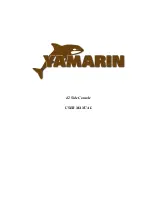
SAFETY-2
used most often by people participating in water
sports, as it is generally the most comfortable type
for continuous wear.
Type IV (Throwable):
United States Coast
Guard regulations require at least one (1) throwable
Type IV PFD to be on board, regardless of the num-
ber of passengers. The Type IV PFD is not intended
to be worn; it is intended to be thrown to a person
who has fallen overboard and is conscious. The Type
IV PFD is held by the user until rescued. The most
Note:
United States Coast Guard regulations for the
number and type of PFD’s are the minimum required.
Silverton recommends exceeding the minimum
requirements for your safety and the safety of your
passengers.
Type II (Wearable):
This near-shore PFD
provides less buoyancy
than a Type I PFD. It
is intended for use in
calm, inland waters or
waters where there is
a greater chance of a
quick rescue. It turns its
wearer to a face up po-
sition as does the Type
I PFD, but the turning
common examples
of Type IV PFD’s are
buoyant cushions or
ring buoys and they
are required to be
immediately available
for use and in service-
able condition.
action is not as pronounced. A Type II PFD may not
turn as many persons to a face up position under the
same conditions as would a Type I PFD.
Type III (Wearable):
Classi
fi
ed as a
fl
otation
aid, the Type III PFD permits the wearer to place
himself in a vertical or face up position, but it will
not do it automatically
as would a Type I or
Type II PFD. The Type
III PFD has the same
minimum buoyancy as
a Type II PFD, but it
has little, or no, turning
ability. It is intended
for use in calm, inland
waters where immedi-
ate rescue is probable.
The Type III PFD is
Fire Extinguishing Equipment
As a yacht owner, you are responsible to maintain
a minimum number and type of portable
fi
re extin-
guishers on board. All
fi
re extinguishers must be
approved by the United States Coast Guard and
be readily accessible and in serviceable condition.
United States Coast Guard classi
fi
cation includes
foam, carbon dioxide and chemical
fi
re extinguish-
ing materials, which are described in detail in the
Portable Fire Extinguisher System Section
of
this Owner’s Manual. Be certain to read and have
a thorough understanding of the portable
fi
re extin-
guishing equipment. United States Coast Guard
minimum requirements for portable
fi
re extinguishers
maintained aboard your yacht are as follows:
Yachts longer than 26 feet and shorter than
40
feet:
Two (2) Type B-I or at least one (1) Type
B-II portable, hand-held
fi
re extinguisher. If your
yacht has a
fi
xed
fi
re extinguishing system ap-
proved by the United States Coast Guard, one (1)
Type B-I portable
fi
re extinguisher is required.
Yachts longer than 40 feet and shorter than
65 feet:
Three (3) Type B-I or one (1) Type B-I
and one (1) Type B-II portable, hand held
fi
re
extinguishers. If your yacht has a
fi
xed
fi
re extin-
guishing system approved by the United States
Coast Guard, two (2) type B-I or one (1) Type
B-II portable
fi
re extinguisher is required.
Note: United States Coast Guard regulations are the
minimum requirements. Silverton recommends ex-
ceeding the minimum requirements for your safety.
•
•
Summary of Contents for 33C
Page 1: ......
Page 6: ...INTRODUCTION 6 ...
Page 8: ...INTRODUCTION 8 ...
Page 12: ...INTRODUCTION 12 ...
Page 28: ...GETTING FAMILIAR 8 ...
Page 32: ...GETTING FAMILIAR 12 ...
Page 41: ...GETTING FAMILIAR 21 ENGINE COMPARTMENT ...
Page 42: ...GETTING FAMILIAR 22 LAZARETTE ENGINE ROOM ...
Page 43: ...GETTING FAMILIAR 23 FORWARD BILGE ...
Page 44: ...GETTING FAMILIAR 24 ...
Page 50: ...SAFETY 6 ...
Page 54: ...SAFETY 10 ...
Page 68: ...SYSTEM OPERATIONS 6 ...
Page 70: ...SYSTEM OPERATIONS 8 ...
Page 74: ...SYSTEM OPERATIONS 12 ...
Page 82: ...SYSTEM OPERATIONS 20 ...
Page 90: ...SYSTEM OPERATIONS 28 ...
Page 94: ...SYSTEM OPERATIONS 32 ...
Page 98: ...SYSTEM OPERATIONS 36 ...
Page 102: ...SYSTEM OPERATIONS 40 ...
Page 106: ...SYSTEM OPERATIONS 44 ...
Page 108: ...SYSTEM OPERATIONS 46 ...
Page 120: ...SYSTEM OPERATIONS 58 ...
Page 122: ...SYSTEM OPERATIONS 60 ...
Page 124: ...SYSTEM OPERATIONS 62 ...
Page 126: ...SYSTEM OPERATIONS 64 ...
Page 130: ...SYSTEM OPERATIONS 68 ...
Page 132: ...SYSTEM OPERATIONS 70 ...
Page 134: ...SYSTEM OPERATIONS 72 ...
Page 136: ...SYSTEM OPERATIONS 74 ...
Page 150: ...OPERATION 6 ...
Page 156: ...GLOSSARY 6 ...
Page 158: ...GLOSSARY 8 ...
Page 159: ...GLOSSARY 9 MAINTENANCE LOG DATE MAINTENANCE PERFORMED HOURMETER ...
Page 160: ...GLOSSARY 10 MAINTENANCE LOG DATE MAINTENANCE PERFORMED HOURMETER ...
Page 162: ...GLOSSARY 12 ...
Page 165: ...GLOSSARY 15 ...
Page 166: ...GLOSSARY 16 ...
Page 167: ...GLOSSARY 17 ...
Page 168: ...GLOSSARY 18 ...
Page 171: ...33 Convertible ...
Page 172: ...33 Convertible ...
Page 173: ...33 Convertible ...
Page 174: ...33 Convertible ...
Page 175: ...33 Convertible ...
Page 176: ...33 Convertible ...
Page 177: ...33 Convertible ...
Page 178: ...33 Convertible ...
Page 179: ...33 Convertible ...
Page 180: ...33 Convertible ...
Page 181: ...33 Convertible ...
Page 182: ...33 Convertible ...
Page 184: ...33 Convertible ...
Page 185: ...33 Convertible ...
Page 186: ...33 Convertible ...
Page 187: ...33 Convertible ...
Page 188: ...33 Convertible ...
Page 189: ...33 Convertible ...
Page 191: ...33 Convertible ...
Page 192: ...33 Convertible ...
Page 194: ...maxwell 33 Convertible ...
Page 195: ...33 Convertible ...
Page 196: ...33 Convertible ...
Page 197: ...33 Convertible ...
Page 198: ...33 Convertible ...
Page 199: ...33 Convertible ...
Page 201: ...33 Convertible ...
Page 202: ...33 Convertible ...
Page 203: ...33 Convertible ...
Page 204: ...33 Convertible ...
Page 205: ...33 Convertible ...
Page 206: ...33 Convertible ...
Page 207: ...33 Convertible ...
Page 208: ...33 Convertible ...
Page 210: ...33 Convertible ...
















































